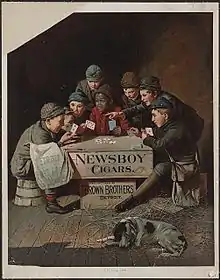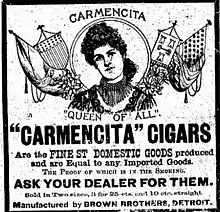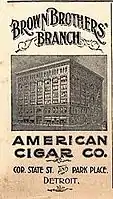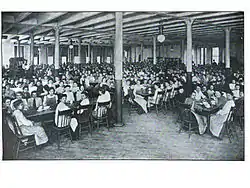Brown Brothers Tobacco Company was located at 119 State Street in Detroit. The building was built for brothers, Robert Hamilton Brown and John Brown who founded a cigar manufacturing business which was, at one time, the largest cigar factory under one roof in the world. Brown Brothers were known for the following cigar brands: Newsboys, Cremo, Fontella, Carmencita, Evangeline and Detroit Free Press.[1][2][3][4][5]

Company founding

Robert Brown, born in Ohio of Irish descent, and his brother, John H. Brown, founded the firm. Robert was a Civil War veteran who received honorable discharge, having been a private in an Ohio regiment. In the late 1800s, Brown moved to Detroit and started a fire insurance, real estate and lumber business with his brother John (who had previously moved to Detroit) on Griswold Street in Detroit. They later started the cigar business on Monroe Avenue and John managed the enterprise.[6][7]
Building
In 1887, famed Detroit architect, Gordon W. Lloyd designed the company's new building at 119 State Street in Detroit. Lloyd was an influential architect known for his Gothic Revival and later Romanesque Revival designs. The building was originally at 33 State Street prior to the renumbering of buildings in Detroit which occurred in 1921, after which the building became located at 119 State Street.[2][8]
Advertising
Advertising for its brands included cabinet cards of prominent performers for Newsboy.[9]
Cigar strike 1895
In the summer of 1895, a city-wide strike of the unionized cigar makers occurred as a result of the manufacturers utilizing lower cost and wage options such as machine rolling and female employees and child labor. In June of that year, the local union president authorized the strike indicating that all men could walk out. The issue of female and child labor became a cause-celeb in this struggle with an executive in the American Federation of Labor being quoted as saying:
When a cigar manufacturer runs a "Union shop" and employs union men and women he is allowed the use of the Cigar Makers' International Union blue-label, which guarantees to the public that the cigars having this label upon the box have been made by well paid, clean and skilled labor, but when a manufacturer...takes cigars made by underpaid women and children and mixes them with the cigars made by union labor in his regular shop, he not only takes advantage of the helpless women and children, but aims to reduce wages and impare [sic] the standard of workmanship of union labor, and through false pretenses defrauds the smokers of Union labeled cigars.
The strike wore on throughout the summer and in August, the Brown Brothers made headlines by importing fifty scab laborers from Cuba under the guise that these men would be involved with the manufacture of high end, Havana cigars only. The strikers assumed that the Cubans would be replacing the female workers who went on strike in June of that year.[10]
By 1897, the American Federation of Labor placed the Brown Brothers tobacco products on the "unfair" list as not being fully in support of organized labor or an organized labor workforce. Pro-labor newspapers carried stories of the firm employing only women and children and not paying a union wage. Tensions were clearly not assuaged from the recent strike. Several other cigar manufacturers, including, the American Tobacco Company, were placed on the more punitive, "do not patronize" list. By 1900, however, the Brown Brothers were added to the "do not patronize" list.[11][12]

Company operations
In 1899, the company filed suit in Ohio court against Frank Torrence, a former employee and travelling salesman of Brown Brothers and against Bucher and Bucher Company of Ohio. The suit alleged that Torrence and Bucher conspired to offer a substandard 5-cent cigar, by the trade name of "La Camerita", to under-cut Brown Brothers by deceiving the customers who were interested in buying Brown Brothers' premium 10-cent cigar by the similar name of "Carmencita". The suit alleged that "La Camerita" was a "fanciful name invented and adopted by the defendant because of its close resemblance to the trade-mark of the plaintiff" (Brown Brothers). The suit further alleged that the former salesman, Torrence was an irresponsible person financially. Citing Bradbury v Beeton, a suit between the comic strip "Punch" and "Punch and Judy", the court found in favor of the defendant and injunctions against the defendant were removed. The court ruled that there was not sufficient proof that Torrence (and Bucher and Bucher) intended to deceive the public.[13]
American Cigar Company
The American Cigar Company was incorporated in 1901 with an initial capitalization of $10 million, later increased to $20 million. The American Tobacco Company and the Continental Tobacco Company forged a business arrangement with Powell, Smith and Company to compete on a larger scale in the business of cigar manufacture and sales. American and Continental each acquired 46.5% of the new entity and Powell the remaining 7%.[14][15] In 1901, the American Cigar Company, purchased Brown Brothers Tobacco for over $469,000 in stock and cash and renamed it "Brown Brothers' Branch, American Cigar Co." At the time, Brown Brothers had an annual capacity of over 40 million cigars, 1,076 employees and was the largest manufacturer of cigars under one roof in the world. When the firm purchased Brown Brothers, press reports indicated another 1,000 employees would be hired at the factory.[16]
Initially, John Brown was retained as the manager of the operation however, he resigned in May 1902 after being directed to reduce operating expenses which meant a reduction in workers' wages. Brown officially claimed that he resigned due to "ill health" and the "need for a rest". In protest of Brown's departure and with concerns of wage cuts, the employees staged a strike. The strike involved 1200 female and 50 male employees. In a speech to the striking employees in late May 1902, Brown admitted that he did not like having to report to the third vice-president of the American Cigar Company; a man named "Weiss". He did however, encourage the employees to return to work, stating, "Go back to work. Go back until you find your wages are really being cut and then quit." The employees refused to listen to Brown and remained out on strike through June. The women formed a union but in the end, lost the strike and Brown Brothers remained a non-union enterprise.[4][5][17][18][19][20][21]
By July 1903, John Brown had raised over $1M in capitalization to found an independent cigar manufacturing company that would compete against the "trust" or against the American Cigar Company as it moved to monopolize the cigar industry. Later that year, John's brother Robert, died in Florida, having suffered as an invalid for the last eight years of his life.[6][22]
Through 1906, the American Tobacco Company purchased a number of other cigar and cheroot manufacturers across the country and into Cuba and Puerto Rico.[17] The next year, trade journals began to report that the American Tobacco Company did not intend to renew its lease on the Brown Brothers factory on State Street in Detroit. Rather, they intended to build a new factory in the Polish district of the city where the majority of the workers resided. By 1910, it was announced that the American Cigar Company had purchased a build site and intended to build a seven story factory. The business was managed by William Lichtig at the factory, a position he had held since 1903 shortly after John Brown left the operation. Lichtig left the business in 1911 to form the Surety Cigar Company along with Mose Eisenberg in 1911.[23][24][25][26]
In 1911, in a landmark antitrust case against American Tobacco, United States v. American Tobacco Co. the courts ruled that the company had violated the Sherman Antitrust Act and divestiture of American Tobacco was ordered.[27]
The obituary of John H Brown was announced in the United States Tobacco Journal. He died in early 1914 at the age of 65 and was survived by four sons: Percy M., John Stanley, Harry and Alfred D. Brown. At the end of his life, he was the owner of Clark Mineral Springs Company in Detroit.[28][29]
By 1921, the American Cigar Company was still in operation in Detroit. The factory was then located at 3818 Beaubien Street.[30]
21st century
In September 2015, it was announced that the building at 119 State Street would be sold to Lear Automotive by Dan Gillbert's Bedrock Real Estate Services.[31]
 Brown Brothers' Branch American Cigar Co. newspaper advertisement
Brown Brothers' Branch American Cigar Co. newspaper advertisement photograph of the dining hall at the Detroit Brown Brothers Branch factory
photograph of the dining hall at the Detroit Brown Brothers Branch factory
References
- ↑ "119 State Street" (PDF). www.bedrockmgt.com/. Bedrock Real Estate Services.
- 1 2 Detroit City Directory 1893-4 (Vol III ed.). Detroit: R.L. Polk & Co. 1893. p. 125.
- ↑ Michigan State Gazetteer and Business Directory (Vol XIII ed.). R.L. Polk. 1897. p. 520.
- 1 2 The Government of the City of Detroit and Wayne County, Michigan: 1701 to 1907. Detroit: Mannausa and Wieber. 1907. p. 17. ISBN 9780598455529.
- 1 2 Cigar Makers' Official Journal (Volumes 28, 29. No. 11 ed.). Cigar Makers International Union of America. 15 August 1905. p. 14.
- 1 2 Leake, Paul (1912). Title: History of Detroit, a chronicle of its progress, its industries, its institutions, and the people of the fair City of the straits. Chicago: The Lewis Publishing Company. pp. 1114–1115.
- ↑ Detroit City Directories (Volume 1 ed.). Detroit: J.W. Weeks and Company. 1879. p. 214.
- ↑ "Detroit Renumbers Information". www.stevemorse.org/. Retrieved 29 September 2015.
- ↑ http://www.newsboys.co.uk/Newsboy%20article.pdf
- ↑ DeVault, Ilene (2004). United Apart: Gender and the Rise of Craft Unionism. New York: Cornell University. pp. 100–103.
brown bros cigars detroit.
- ↑ "Labor Notes". No. 33. The Advocate and News, Topeka Kansas. 17 August 1898.
- ↑ Machinists Monthly Journal (Volume 12, No.1 ed.). Washington D.C.: International Association of Machinists. 1900. p. 65.
- ↑ Ohio Nisi Prius and General Term Reports: Decisions of the Courts (Vol 6 ed.). Columbus, OH: Weekly Law Bulletin Printers. 1899. pp. 379–385.
- ↑ "Tobacco trust found guilty and must dissolve court is to fix legal form of big business". No. vol LX No 19, 494. The New York Times. 30 May 1911.
- ↑ Commercial and Financial Chronicle (Vol 85 Part 1 ed.). NY, NY: Company Publishers. 1907. p. 278.
- ↑ "Business News". The Detroit Free Press. 24 October 1901.
- 1 2 Cigar Makers' Official Journal (Volume 34, Issue 3 ed.). 15 December 1909. p. 2.
- ↑ "The Manager Resigned". Vol. 1, no. 302. The Brainerd Dispatch. 23 May 1902.
- ↑ Jacobstein, Meyer (1907). The Tobacco Industry in the United States. Columbia University. p. 371.
- ↑ Bureau of Labor Annual Report (Vol 20 ed.). Michigan Bureau of Labor. 1903. p. 511.
- ↑ "Reason Brown Resigned". The Detroit Free Press. 24 May 1902.
- ↑ "Will fight the tobacco trust". Benton Harbor, MI. News-Palladium. 8 January 1903.
- ↑ Tobacco Leaf (Vol 44. No 2,200 ed.). 24 April 1907. p. 24.
- ↑ Engineering News Record (Vol 63 No 20 ed.). 19 May 1910. p. 212.
- ↑ Tobacco Leaf (Vol XL No. 38 ed.). 30 September 1903. p. 22.
- ↑ New Cigar Factory for Detroit (Vol XXXI No. 4 ed.). The Tobacco World. 15 February 1911.
- ↑ "American Tobacco Company". Encyclopædia Britannica. Retrieved 3 October 2015.
- ↑ United States Tobacco Journal (Vol 81 ed.). New York. 31 January 1914.
{{cite book}}: CS1 maint: location missing publisher (link) - ↑ United States Tobacco Journal (Vol. 81 ed.). New York. 1914. p. 28.
{{cite book}}: CS1 maint: location missing publisher (link) - ↑ Polk's Michigan State Gazetteer and Business Directory. Detroit: R.L. Polk & Co. 1921. p. 377.
- ↑ Aguilar, Louis (28 September 2015). "Dan Gilbert selling Detroit building to Lear". The Detroit News.